With the growth of social media accounts for dogs, we’ve been getting asked for dog photography tips. Everyone wants to know how to take a great photo of their dog and look like a professional.
Awesome Pawsome Pet Photography’s Trish Aleve gave us her 10 top tips on how to take great dog photos, with the help of her gorgeous chihuahua Buster, the Zoolander of Dogs.
10 Top Tips : How To Take A Great Photo of Your Dog and Look like a Professional Fast
1) Understand Your Camera
I use my iPhone 8+ or a good point and shoot myself, but Sara (The Super Collies), Dryver, Colleen, Aria and Trish, who have all worked with us and love dogs, have DSL cameras with multiple lenses and adjustable controls that allow them to get incredible photos, especially indoors or action.
It is important to understand a few camera basics in order to properly capture our pooches. First, we are going to examine Shutter Speed, Aperture, and ISO.
The Shutter is the device the controls the duration of the photograph’s exposure. The camera’s Shutter Speed, is simply the speed at which the shutter moves. The slower the shutter speed, the longer the shutter is open, which can result in moving objects that appear blurry on your picture. The faster the shutter speed, the less time the shutter is open. A fast shutter speed can ‘freeze’ moving objects in photos. Fast shutter speeds are used for sports and action.
The Aperture is the size of the hole in the lens. The bigger the hole, the larger the aperture, the more light that is let in. The smaller the hole, the smaller the aperture, and less light is let in. This is measured in “f stop”. A “1.8 f stop” is a large aperture and a “22 f stop” is a small aperture. Aperture also relates to how much of the photo is in focus. F/1.8 would have very narrow depth of field, whereas f/22 would have almost all of photo in focus.
ISO is the speed that light hits the sensor. Low ISO will record light slower than a high ISO. The higher the ISO the more “noise” or grain will be present.
Understanding these three camera basics will help you decide on what settings to use when. Play with your camera to get to know it better.

2) Choosing a Location
Now you must choose where to take the picture or pictures. Think about what you want the pictures for. Are you framing a portrait for an occasion like Christmas or building your dog’s profile and influence on social media? Do you want to show your dog in action on the Lure or Agility Course or doing a trick?
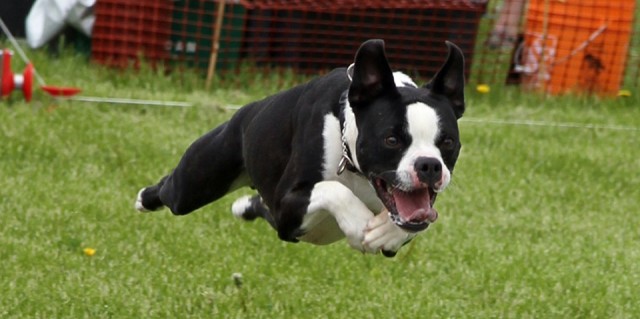
Select different settings to keep it interesting if you are doing a series but keep your style consistent. Aria’s beautiful photos of her dog Beau (RIP) were very consistent in style and colours on his instagram.
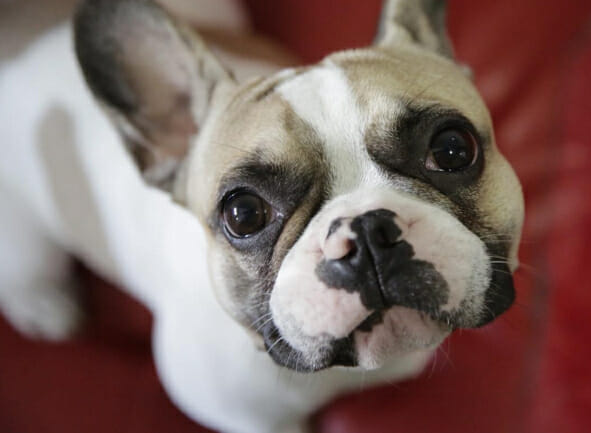
If shooting outdoors, consider locations like the beach, a park, a forest, and in the city. Sara Carson recently posted some stunning shots of the Super Collies having fun hiking. Our friend Jessica from You Did What With Your Wiener has some incredible shots of her dogs hiking and beautiful scenery. Mr N the Tenacious Terrier has been posting some adorable pics travelling around lately and Emma from MY GBGV Life always has incredibly creative photos and scenes, often complete with costumes. Graffiti or street art can make for an interesting backdrop as various friends have shown on Instagram and I just saw an amazing series of photos in black and white of stray cats in Europe.
If you are not doing a single portrait or focused on just your dog for Instagram, consider adding in doggy or human friends, or other animals or maybe a costume – Taylor’s beautiful photos and videos of her two dogs hugging went viral and Doug the Pug is a master of great settings and social commentary through photos.
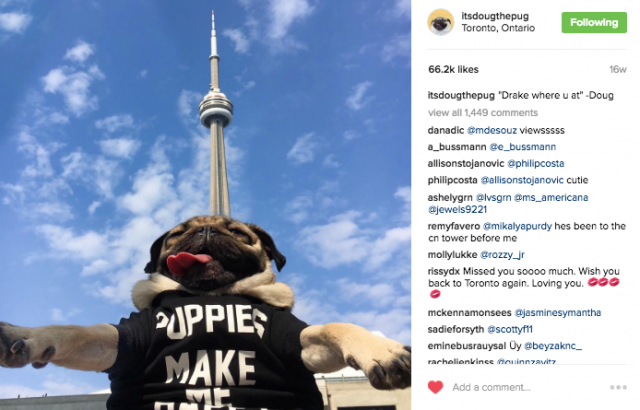
On Instagram, I have noticed celeb dogs like Iggy Joey, Pom Pom Chewy, Kimchi the Corgi or Mr Marcel often collaborate to create even more interest.
Photos of dogs and kids can be very heartwarming.
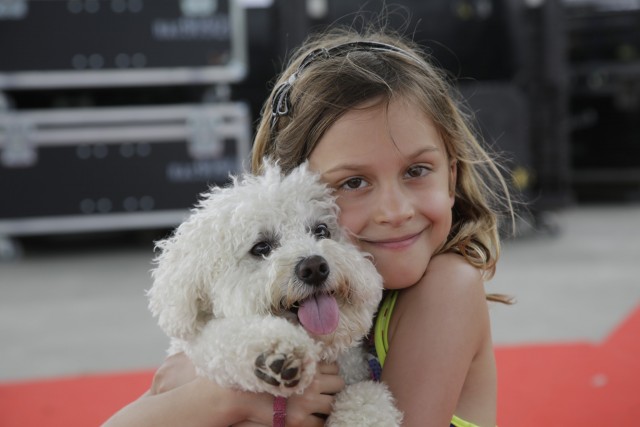
For indoor shots try to use a place that is uncluttered. You can also make your own backdrop by hanging sheets or a blanket. Don’t forget to add in some bright colours that can make your photo pop. Remember green or white may reflect and spots and busy patterns can be tricky. Plain white can either look amazing if well lit or really dull. Now there are often colourful Pop Up Instagram sets to pose your dog on for photos like at the recent Canadian Pet Expo.
Get creative and have fun.
3) Things to Keep in Mind about Lighting
Different lighting conditions need different camera considerations.
For shooting Outdoors: Overcast skies provide the most even light, and gentle shadows, while sunny days produce harsh light, and heavy shadows. Shooting with the sun behind you provides good lighting, whereas backlight (shooting towards the sun or other light source) can be more difficult producing flare, and lack of details in your subject. Avoid mid-day photography, and keep in mind morning and evening light can produce a nice warm hue – great for your morning and evening walkies!
Indoors: Try to use camera settings, and the light from windows and lights. If you have an external light, try bouncing it off walls or the ceiling to diffuse it or using a filter. You may need to use the flash, but you may get devil eyes or scare your dog. Try a few times so your dog can get used to the lights and flash if you have to use one.
4) Depth of Field and Focus
Before you take your picture, consider both your depth of field, and point of focus. Do you want your entire dog in focus, or just part of the dog? Do you want the background blurred or in focus? Determine before you push the shutter button what you would like to accomplish, and what you would like to emphasize. Usually, you will want to ensure your dog’s eyes are in focus – unless you are purposely trying to emphasize another body part such as a nose or paw.
5) Composition
Consider your composition carefully. Always strive for simplicity – uncluttered backgrounds. Where will you put the main subject into the frame? On the right or left? Top or bottom? How much environment do you want to include? Try not to have someone’s foot or a cord or something distracting next to the dog by mistake (we ofthen have that issue at crowded Pet Expos).
6) Be Mindful of Perspective and Size
Dogs are generally shorter than humans. Get down to dog level, and look your dog in the eye. Pictures taken from a standing position, looking down, can prove to be less interesting much of the time. So for small dogs, this may mean getting down on your hands and knees, or even your stomach. And if you are adventuresome, a fun way to get some random pics it to shoot from the hip or ankle if you have a small dog. Try to get the whole dog in the shot as you can always crop. It can look a bit weird if you accidentally cut off one paw or ear.
7) Capture your Dog’s Personality
Convey what you dog is about, and what they like. Are they lazy, or maybe like to sleep, then take photos of them napping in a variety of positions/spots? Do they love to play, then take some photos of them enjoying their favourite toy? Do they like to run, then try your hand at some action photography and panning?
8) Colour of your Dog
Think about the colour of your pet and what will make them stand out for example Kilo the Pug is black and his eyes are dark brown so he looks better on a lighter background indoors or in green grass or beside the blue lake. A white dog can easily end up with the dog being overexposed in the photo or background underexposed. A black dog can end up with dog underexposed, or the background overexposed and no eyes. Also, solid dogs with no markings can be difficult to bring out the details. This is where the right backgrounds, proper lighting, or artificial lighting, and fiddling to get the right exposure can come in handy.
9) Capturing Action Shots
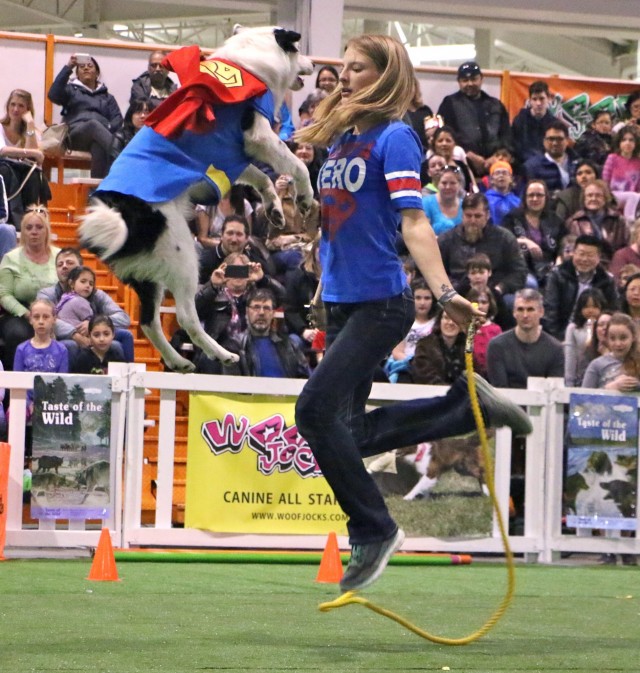
Have some fun getting you dogs in action! Practice lots – you can always delete them! Remember: faster shutter speeds will ‘freeze’ the dog, where slower ones will show movement. Try out different things: pan the camera as the dog runs in front of you, or have your dog run towards the camera. My iPhone now has a way to keep snapping fast so I get a bunch of shots and pick the best.
10) How to make your dog smile, especially if your dog is shy:
Get your dog active and moving as panting will look like a lot like smiling to the camera. Other tricks of having your dog convey human emotions: catch them in a yawn (angry), of putting their head down (sad), etc.
I also put peanut butter on the end of a wooden spoon and give Kilo a tiny lick to get smiles and tongue out or talking.
Bonus TIP: Make it a positive experience!
Kilo’s mouth waters and he gets his Blue Steel look going and starts posing when he sees a camera now. Reward you dog lots with treats, praise or toys. Let them sniff your camera, hear the noises they make, and see what the flash is like if you use one. Give the dog enough time to get used to the camera. Take lots of shots so you have choice.
Be mindful of never directing the flash towards a pup’s eyes.
Remember, basic obedience training and a few cute tricks like sit pretty and hold and wave will go a long way taking photos.
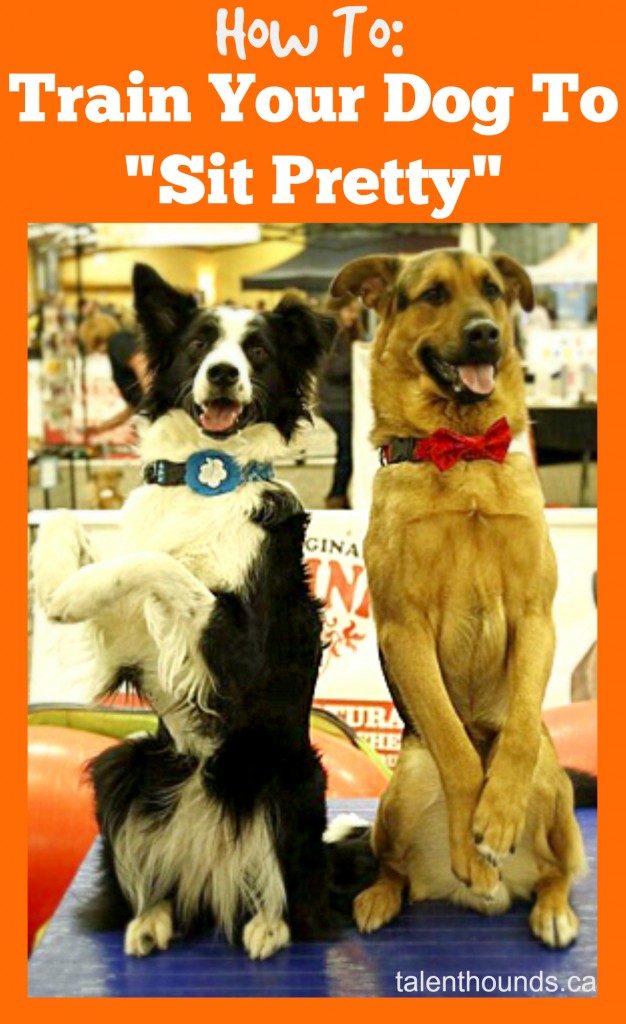
If you lack confidence in your dog’s training, bone up with one of our featured Canadian trainers listed here or our training posts like How to Teach Sit Pretty with Taylor Lottie and Grizzly.. Always have fun, and practice, practice, practice! Work on your dog’s timeline and plans…not yours. If you don’t make it fun for the dog, they will not look forward to pics.
Always ensure safety for both your dog and yourself.
And when you’ve finished your masterpiece, be sure to post it on Facebook and visit us on Instagram @mytalenthounds
Visit Pawsome Pet Photography for more information.

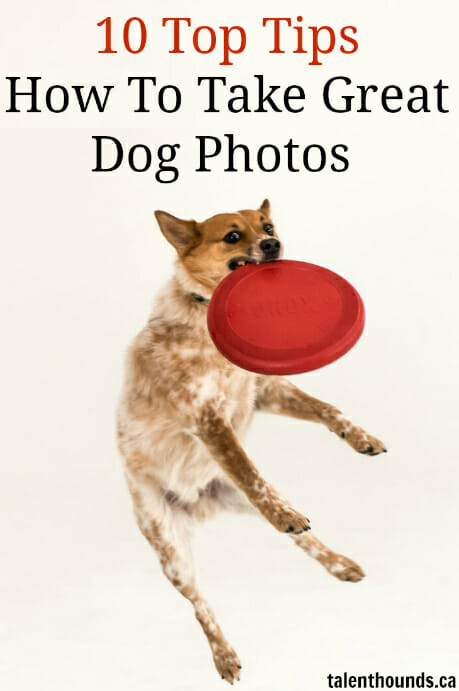
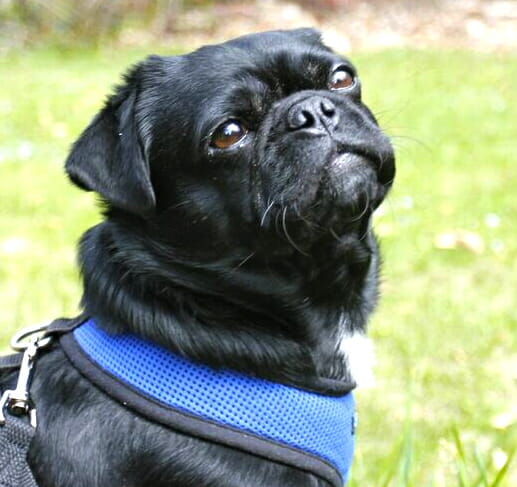
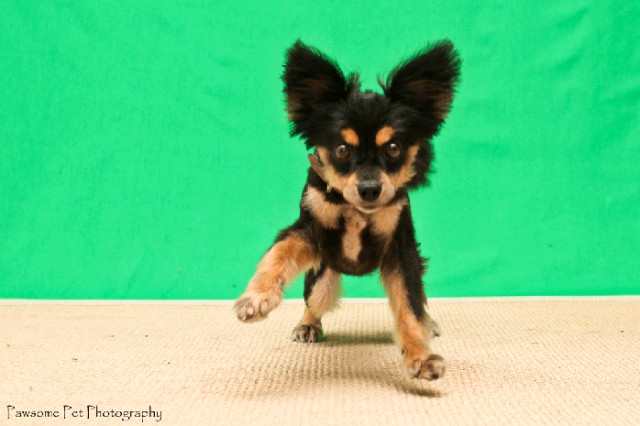
Thanks for these tips! I need to learn more about my Cannon camera by Going online to find their user manual. I’ve had it for over a year and have yet to do that! I have no idea where any of these settingd are, I miss the days of gadgets including printed manuals that tell you how to use them! I’d love to learn how to take action shots on my camera.
Love & biscuits,
Dogs Luv Us and We Luv Them
Me too Cathy. Aria’s cameras terrify me. I have not even finished the manual on one of mine and had to get her to help me with the settings LOL. I LOVE action shots.
Those are some great tips. Thank you for including us. My photographer is always striving to be better, to find new tips and things to make our photos better. I always say it helps because she has me as her model.
The model is certainly key and you are a supermodel Emma XS
These are great photography tips. Mommy needs to learn about her camera more.
This is a really great and informative post! I have a “real” camera and I know I need to take a course on how to use it. But your post here definitely helped teach me as well. Thank you!
I love my DSLR camera. I have a Canon T5 so just your basic beginner DSLR. I am always looking for great tips though because you can never stop learning on how to improve your photography game. And cats/dogs are some of the most difficult beings to photograph..they never stop moving haha. Thanks for posting!
I take all my photos of Edie on my iPhone, but I am forever looking for new and inventive way to “up my game” when it comes to improving my photos. Thanks for this post!
Thanks for this great info as I am still learning
These are awesome tips! Unfortunately, I think that even with an amazing camera I would still need a whole team of stylists, lighting technicians and trainers to pull off some of the great examples you included. That being said, we are coming up on my favorite time of the year and so I am going to attempt to implement some of your tips in capturing my dogs out in the fall colors and lighting. Thanks!
Great tips on photographing a dog. Thanks. Great photos too. 🙂
Thanks for all these tips. As hard as I try I just can’t seem to take a good picture!
Wonderful tips! I still have a lot to learn about photography. These are definitely things to keep in mind when photographing pets.
This is a very informative and truly selfless post, thank you for sharing your skills and talents with us! I struggle with photography – sometimes they are good and other times not so much. So I appreciate all of the tips – the one about know your camera… painfully true (I got a super nice camera that I just don’t know how to use) – and the one about how to get your dog to smile is fabulous!!
Thanks for including us. I’m still learning a lot as we go! Action shots are my nemesis.
I need to save this for future reference. I purchased a Nikon 3300 recently and need to learn how to use it.
It’s probably a bad thing that I saw step 1 and was like WELP! I don’t know what any of those words mean; I’m doomed. LOL 2017 is the year I want to really learn how to use my camera. I think I have almost everything else, down to the back drops and the photo light, under control. JUst have to figure out what all those buttons do…
Me too LOL. I have been back to the store twice to get things reset even on my simple cameras. Your photos always look great, especially treats. I find food incredibly difficult to shoot.
Great pointers!! I’m still learning all the features in my Nikon D7100 (it’s been almost a year!) so reminders are ALWAYS good! I’m going to go find your ‘sit pretty’ guide now… a friend has been working on this. 🙂
Great photo tips for animals and even human subjects too.
Great article!! Capturing your pet in the right position, with the perfect background it always a hassle!! But I’m getting better at it! Practice makes perfect :D!!
This post was really helpful. Im going to start putting them to good use when im clicking away with the camera
Love your peanut butter trick for Kilo! I actually took a quick photography class last fall and it made such a huge difference. Up to that point, I had always just used the automatic setting on my camera and now I rarely do. Also, upgraded my lens so I can zoom in from quite a distance – this is especially helpful if you are photographing shelter or shy animals. You can get close up without getting in their space and making them nervous.
Yes a good lens can make all the difference. Aria and Trish have several but I find I am not careful or patient enough to manage.
These are great tips for pet photography. I delete many rushed, blurry or dark photos from my phone. I need to take a few seconds to set the shot.
Great tips! I love seeing wonderful photos of dogs, but they aren’t always easy to get!
Great post with lots of helpful reminders! We try to be mindful of many of your tips whenever we take photos. We are now also more aware of ways to frame photos for their use on varying social media platforms with different size preferences!